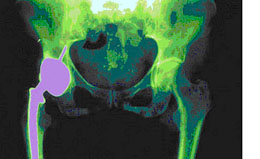Total Hip Replacement Innovation
Total Hip Replacement is a remarkable medical innovation that has restored personal mobility to ten’s of millions of people. This X-ray of a hip prosthesis demonstrates the remarkable achievement of total hip replacement surgery. This ability to restore personal mobility is one of the wonders of orthopedic innovation in the 20th century and offers hope and inspiration for continued medical discovery and enhancement of life.

An American surgeon, Austin T. Moore and Sir John Charnley of Manchester, England are generally recognized as the early innovators of total hip replacement. In 1942, Dr. Moore performed the first metallic hip replacement. He replaced the entire upper portion of the femur with vitallium prosthesis a foot long.
Consistent with the typical pattern for incremental medical innovation leading to revolutionary change, the design of the prosthesis and the procedure improved dramatically over the years with contributions by other surgeon inventors. Dr. Charnley added a self-curing cement to anchor both the femoral replacement and the acetabular cup.
He also introduced an invention to reduce friction and wear by replacing Teflon (PTFE), with more durable and shock absorbing high-density polyethylene. Building off the continued incremental innovations of surgeons and biomedical engineers, the Austin-MooreTM prosthesis derived from this early innovative work is used today by orthopedic surgeons to consistently restore the ability to walk to ten’s of millions of people globally.
Click on Invention Roadshow Registration to present your medical invention.
